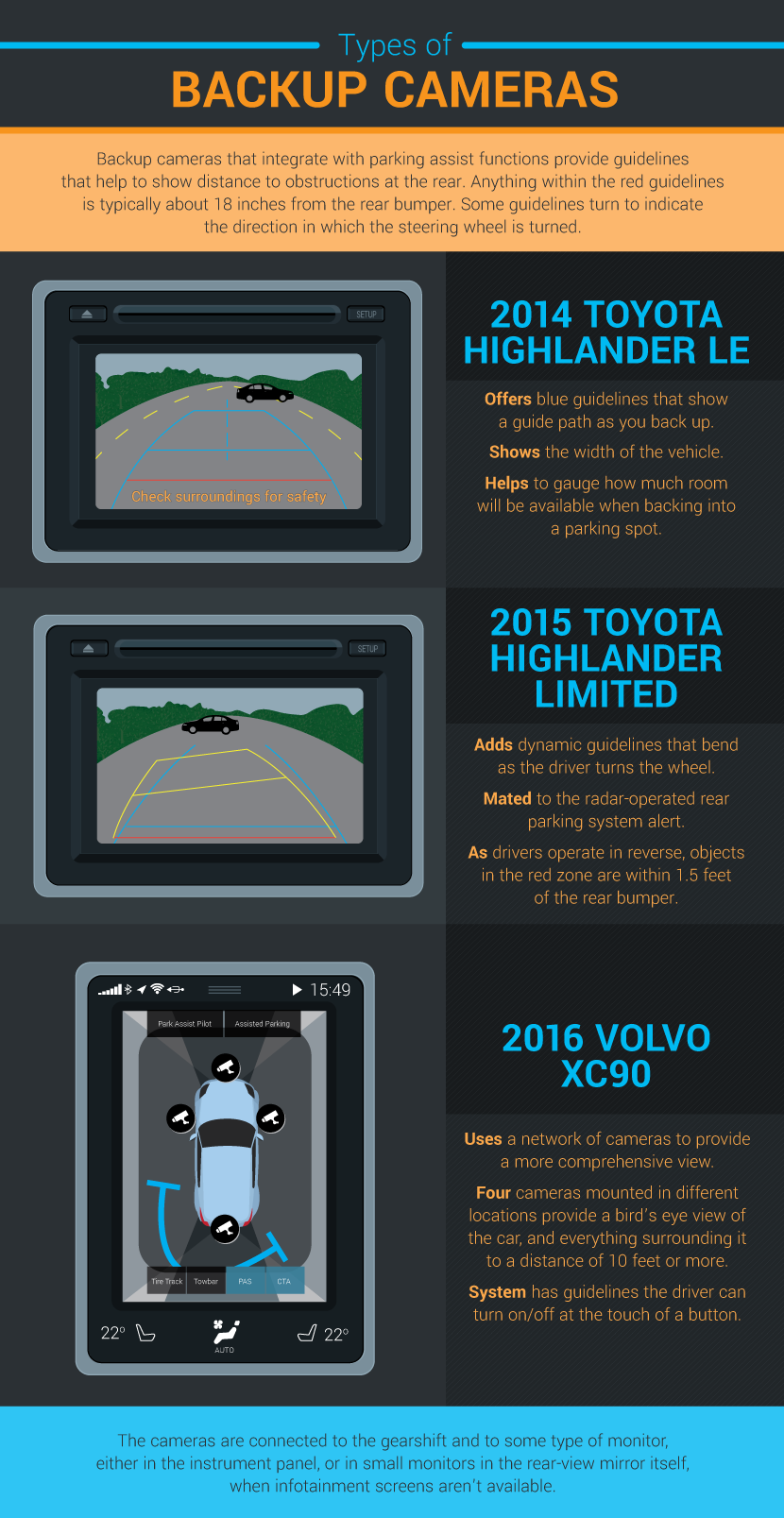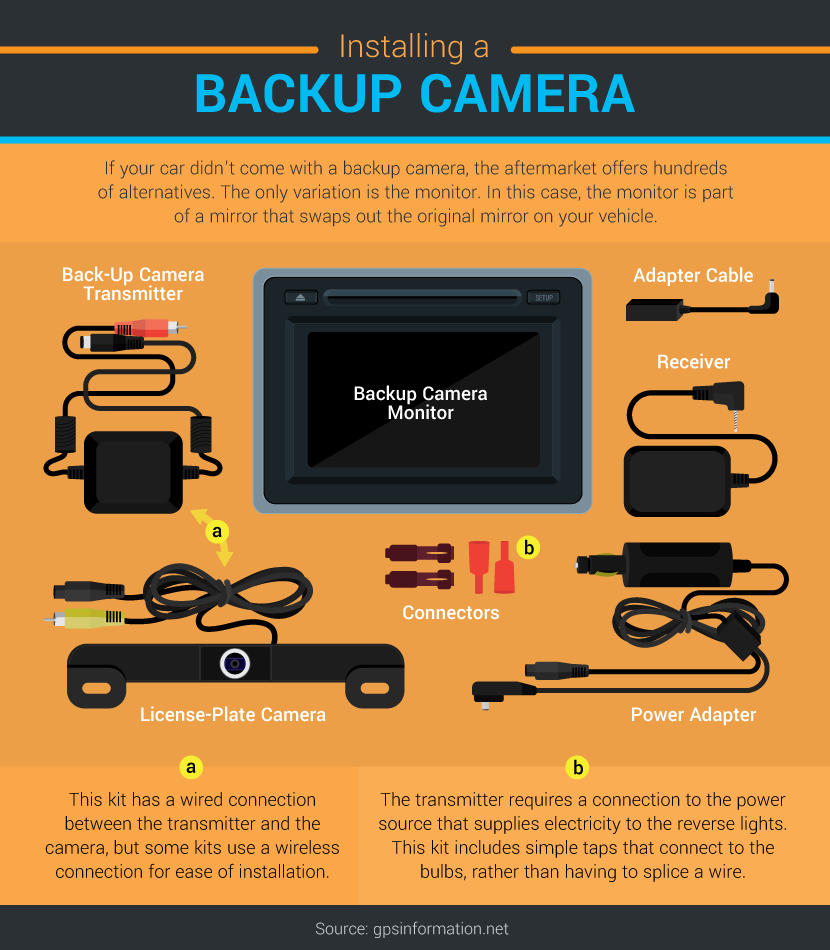The Rise of the Backup Camera
Your Options For Rear Visibility Technology
As of 2016, we’re at the very moment when backup or rear view cameras reach their tipping point and become a regular part of everyone’s driving experience.
The idea for utilizing a camera connected to a screen on the instrument panel might have been the kind of “flying car” fantasy of Popular Mechanics in the 1950s,
but in the last 15 years, it’s become a solid reality, and it’s about to become a part of every car sold in the United States.
What is a Backup Camera?
Backup or rearview cameras are small, wide-angle cameras mounted in the rear of a vehicle, and connected either to the infotainment screen on the instrument panel, or a small monitor in the rearview mirror itself.
The idea for a camera replacing a rearview mirror can be traced back as far as 1956, when Buick introduced the Centurion concept car at the 1956 Motorama Show in Detroit. According to the GM Heritage Center’s website,
“the Centurion featured a television camera in the rear to report traffic to the driver via a television screen in the dashboard, replacing the rearview mirror.”
The Centurion’s camera never made it to production, and the idea never really came to fruition for another 50 years. In 1991, the Japan home market Toyota Soarer Limited featured an early backup camera, operated when the gearshift was placed in reverse.
However, it would be another decade before the technology finally made it to a car sold in the United States.
The 2002 Infiniti Q45 featured "RearView Monitor” technology when it made its debut at the 2000 New York International Auto Show.

Why Are They Important?
Modern vehicles seem to get harder to see out of every passing year.
In the 1970s, most cars were boxy and featured a tall “greenhouse” above the beltline that provided a fairly unobstructed view of all four corners. Inside, if there were headrests at all, they were small, and only on the driver and passenger seats.
Today’s vehicle designs are radically different from those of the 1970s. Roof strength standards mean that B-pillars (and C-pillars in crossovers, SUVs, and minivans) are much more pronounced than they once were.
Inside, sightlines are obstructed by two headrests for the front passengers, and as many as five headrests for rear-seat and third-row passengers.
The vehicles we drive make seeing out the back harder, too. Even if you’re turned around in the driver’s seat and looking out the back window, it’s difficult to see what’s just beyond the bumper in a full-size SUV or a minivan, with deeply tinted windows.
In 2010, the National Highway Traffic Safety Administration noted that 207 people were killed annually by cars backing over them without the drivers seeing anything in the rearview mirror. Additionally, nearly 15,500 people were injured in similar accidents.
What makes the accidents more tragic is who they happen to. Healthy adults can generally either step out of the way of a backing vehicle, or alert the driver that they’re about to be struck.
Small children and disabled adults can’t, and they bear the brunt of fatalities.
According to NHTSA’s proposed rules, installing backup cameras and monitors in all vehicles with a gross vehicle weight rating of 10,000 pounds or less could result in a 46 percent reduction in fatalities.In March 2014, NHTSA issued a final rule, which required “rear visibility technology in all new vehicles under 10,000 pounds by May 2018.”

How Do Backup Cameras Work?
The most common backup cameras are small, wide-angle cameras mounted unobtrusively under the edge of the trunk lid or the cargo hatch handle. They’re typically positioned in the trim surrounding the handle or the trunk lid, and point at a downward angle.
The cameras are connected to the gearshift and to some type of monitor, either in the instrument panel, or in small monitors in the rearview mirror itself, when infotainment screens aren’t available.
When the driver places the gearshift in reverse – either in a manual or an automatic transmission – the camera instantly turns on and the screen displays the image that the camera sees.
What Types of Rear Visibility Technology Exist?
In their most basic form, backup cameras simply display what’s behind the car.
The backup camera on a 2014 Toyota Highlander LE, LE Plus, and XLE additionally offers blue guidelines that show a guide path as you back up.
The lines are meant to show the width of the vehicle and help drivers gauge how much room they have when backing into a parking space, for example.
The 2014 Highlander Limited goes one step further: It adds dynamic guidelines that bend as the driver turns the wheel. The guidelines are also mated to the radar-operated rear parking alert system.
As drivers back the vehicle up, objects in the red zone are within one and a half feet of the rear bumper.
Vehicles like the 2016 Volvo XC90 use a network of cameras to provide an even more impressive view. Four cameras mounted in different locations provide a bird’s-eye view of the car, and everything surrounding it to a distance of 10 feet or more.
The system has guidelines the driver can turn on and off at the touch of a button.

Are There Any Problems with Backup Cameras?
There are a few things to think about when buying a car with a backup camera. The biggest concern is weather-related. If you live in an area where you drive through heavy snow, salt, dust, or mud, the backup camera can be completely obstructed,
to the point where you may have to clean it off the way you’d wash your windshield.
Some manufacturers have come up with ways to combat the obstruction. A few manufacturers use washer nozzles to clean the camera off when a driver activates the windshield washer.
Volkswagen actually hides the camera under the chrome “VW” emblem in most of its cars now, which doubles as the trunk or cargo hatch handle. When the driver shifts into reverse, a tiny motor flips the emblem up to expose the camera.

What if My Car Doesn’t Have a Backup Camera?
The aftermarket provides a wide array of solutions if your car isn’t equipped with a backup camera from the factory. The best aftermarket backup cameras take 640x480px video, but also back that up with a wide,
130-degree view so that you can not only see what’s directly behind you, but to the sides of the car, as well.
These cameras are typically mounted on a frame that tucks behind the rear license plate so they won’t alter the aesthetics of your vehicle.
The best aftermarket backup cameras also have some form of lighting to provide a clear view even when it’s dark and the reverse lights aren’t bright enough to illuminate the entire field of vision.
These systems feature LED lights that bathe up to 25 feet behind the vehicle in bright light to see people and obstructions.
To make installation as easy as possible, the best aftermarket rearview systems have a wireless connection between the camera and the screen.
However, they still require a bit of technical know-how because the transmitter that makes them work needs to be hardwired to the wire that turns the car’s reverse lights on.
Finally, if there’s a major disadvantage to aftermarket backup systems, it’s that the monitor isn’t integrated with the car’s infotainment screen.
Aftermarket systems either have a separate screen – that can act as a monitor for a DVD or streaming video player – or a replacement rearview mirror with an integrated screen.
Use this information to help inform your search for a backup camera on your own vehicle!
Embed the article on your site

